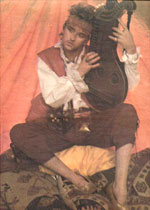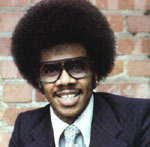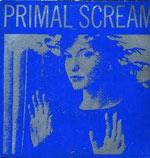Don't Hang The DJ | |

| In what must, please God, be the dying gargle of ooh-weren't-the-80s-great-in-an-kitschy-kinda-way TV, the BBC recently saw fit to unearth all its creaky footage of Rusty Egan, Robert Elms and the fat one out of Adam and the Ants to proffer an idiots' guide to New Romanticism. Brushing aside the only real reason for the cult's existence (a collective consciousness that Scary Monsters (1980) was the last decent Bowie album and there might be a chance to fill the gap for someone), the overwhelming feeling was that the movers and Rudolph-Valentino-in-The-Sheikh-ers of The Cult With No Name were still keen to maintain the droll elitism that kept the whole thing running in the first place. This may have been fair enough when a cloakroom job at Billy's was indeed a Golden Ticket, but it's a bit sad to see middle-aged casualties like Steve Strange and Marilyn getting snotty about how talentless Sal Solo was, or the fact that nothing was going on in the provinces (cue shots of Duran and ABC - ooh, this must be that irony thing they taught us in Media Studies). Even as I sneered at these crumbling idols (I'm of an age to have perused the musings of the Kemp Brothers in Smash Hits) I was also jealous. However pitiful and washed-up they are now, they had something special in their hinterlands, a dim memory of a cultural moment that put them at the centre of a universe. The advantage they have over the millions who claim to have seen the Pistols at the 100 Club or Oasis at King Tut's is that the cameras were always rolling at Billy's or Le Kilt or the Rum Runner, ready for a researcher who wasn't born in 1980 to drag the tapes back into the vodka-and-lime-light. Across the nation, 40-year-olds gasp at their surly offspring - "See Marie Antoinette with a goatee and gauntlets - that's your dad!" But anyone can create a Club For Heroes from their teens, and its obscurity is possibly what bestows upon it retrospective magnificence. If your formative dancefloor memories stem from scout hut discos in Oswestry, there's probably only a select few with whom you can share them - a tightness that makes Strange, Egan and co seem like production-line handbag-dancers. My own crucible of cool was pretty damn obscure to all but a few hundred - and yet, if the right people had been editing The Face at the time, it could have been a terpsichorean nirvana to rival the Wigan Casino. Except it was in Exeter. That's Exeter, Devon. Where the cream teas come from. Sorry. Exeter suffered from many things, not least an isolated location, tribalism between locals, students and Marines and a licensing authority that demanded all clubs closed at one o'clock. Despite this, there was a clutch of excellent post-punk bands and a weekly club night called Shakedown that brought a mix of rare groove, jazz and house to the hungry provincials. It was a beacon of good taste in a clubland dominated by chart-based silage, implied violence and seriously bad hair. But surely there was space for something a wee bit different, something that wasn't just transplanting the vibe of London's Wag Club to the south-west peninsula. And then, suddenly, there was. It was called Creation, a tribute to the record label. Now, before you sneer, remember that at this stage (1986-88) the empire of McGee was all polka-dot guitars and jangling shirts. Primal Scream had a 12-string and Guy Chadwick was ready to slip the House of Love onto the vacant throne when Morrissey and Marr finally went out in an atonal suicide pact. Noel Gallagher wasn't even a roadie for the Inspiral Carpets yet, and the only music supremo to get into a party at Downing Street was Andrew Lloyd Webber. |

| Not that Creation was just a wonky-quiffed, gladioli-and-mum's-blouse indie club, though. The decks were ruled by two teenagers united by their passion for great music and divided by what that music was. The indie element, and the choice of name, was provided by Lewis Burns-Allen, a one-armed Brighton kid who had the C86 logo tattooed on his brain. But to balance this there was Frank Tope, a lanky South London soulboy who could be provoked to near-violence if Dire Straits appeared in a pub jukebox (and in 1986 this was a better-than-evens likelihood). Frank brought to the party a selection of Northern soul, Motown, funk and go-go, topped off with hip-hop nuggets that still sounded bizarre to white provincial ears - 'Walk This Way' may have hit the Top 10, but it was almost as a novelty hit. Look at the funny men with no laces in their shoes, mummy. Now, can you buy me 'The Chicken Song' from Woolworths? This dialectical clash between 'black' and 'white' musics was the club's brilliance - not only did Creation attract twice as many punters as a monocultural event might have managed, but there were moments of epiphany when dancers realised that 'genre' is just another poncy French word. Critical analysis will tell you that the lyrics to 'Tears Of A Clown' are just as droll and yearning as anything Morrissey came up with - and similarly, if you can't move your hips to 'Crash' by the Primitives, even Bobby Byrd isn't going to shift yo' ass. But to see these simple facts dawn as dancefloor epiphanies was to believe that music really could have the whole world holding hands (but without Phil Collins flying from Wembley to Philadelphia to prove it). There was a streak of elitism of course. The dress code was pretty clear - crisp white shirt or black polo-neck, too-big 501s, Doc Martens (black steelies or greasies). Hair short, brylcreemed within an inch of its life, or covered by a red spotted handkerchief. Trainers (and younger readers will just have to believe me on this) were worn only by the irredeemably naff, and the most prevalent brand was Hi-Tec. Snow-washed jeans and any man-made fibre were also symbols of leperdom. Not that their wearers were turned away - the posse on the door (Claire, Emma, Jane, Charlotte, Kathryn, Tracey) would switch into 'Prufrock' mode, take the anoraks and snigger. The culprits would tend to hang around uncomfortably for 20 minutes, then the bravest would be sent to request something by Queen or Simple Minds or ZZ Top. Lewis would mumble politely about not having any with him, then giggle behind his artificial hand. Frank would just laugh like a kookaburra. But it wasn't just the mulletted unwashed in their Tina Turner sweatshirts who were victims to Frank and Lewis's turntable fascism. You've got to remember that this was a new dawn for sampling - James Brown was making more from copyright litigation than he was from selling his own material and 'Pump Up The Volume' had us all rifling through Oxfam shops for 1950s-vintage stereo demonstration discs. Frank's favourite scam was to slam on 'Is It Love You're After' by Rose Royce and watch the weekenders clog the floor thinking it was 'Theme From S-Express' - then watch them stagger off in retro-disco confusion. Similarly, Lewis would follow Primal Scream B-sides with new singles from an obscure Northern combo called the Stone Roses and challenge us to tell them apart. |

| The snowglobe of cool could be shaken up a little. When The Osmonds' 'One Bad Apple' was rediscovered as an ersatz-Motown dance masterpiece, Frank attempted to do the same for 'Shang-A-Lang' by the Bay City Rollers. And a melodica-driven Spanish pop-folk instrumental called 'La Yenka' got a new lease of life when the cloakroom girls discovered a set of dance steps on the back cover and led the punters through the stomping like Lionel Blair with nicer dimples. Meanwhile, diehard soul classics might find the door barred. The likes of Marvin Gaye and Sam Cooke were being pummelled into naffness by their use on jeans adverts, and 'I Want You Back', the greatest filler in the history of flooring, reappeared as a shoddy remix and was spurned as if it were a white stiletto. Cheery, instinctive, inclusive eclecticism had its limits. It would be nice to report a steady flow of celebs checking out the action, but they'd have to be pretty damned committed to pop to Devon instead of the Wag or the Haienda or wherever celebs went to before the Met Bar. One day there were rumours that Robert Smith was due to slip in after a Cure gig, but in the event the closest Creation came to bona fide stardom was when Beefheartian weirdos Stump played a characteristically deranged set in 1987. How much is the fish, indeed. But there must have been something in the snakebite. Frank became a respected dance journalist, scribbling for Mixmag, Muzik, The Face and more. Other acolytes of the scene (which in turn gave rise to Jazz Unlimited, Fishtank and other hedonistic floor-packers) included MTV jock Toby Amies, Lunatic Calm mastermind Shack (as heard on the soundtrack to The Matrix) and, in the last days, a fresh-faced vicar's son called Felix who would end up as half of Basement Jaxx. Oh yeah, and there was this guy called Thom Yorke. Wore a trilby. What happened to him? More importantly, it was a historical signifier for the dissolution of style tribalism that would define the acid house experience. As the Woodentops and the Thrashing Doves melded seamlessly with custom-built R-303-based tracks in fields in the Home Counties, one could see it as a final vindication to the seemingly bizarre theory that the Buzzcocks were a soul band, or that, sorry, Moz, Trouble Funk had something to say about my life. Demographics dictated that only about four black people ever showed up - but that was probably fifty per cent of the Afro-Caribbean population of Devon and Cornwall combined. And when 'What' by Judy Street or 'Word Up' by Cameo kicked off, we were all black under our Levis. OK, Boy George didn't work in the cloakroom, Mick Jagger wasn't turned away at the door and Lewis was never interviewed by a middle-aged, trying-too-hard geek for Nationwide. We weren't a cult with no name - we were just looking for some good music when everywhere else was playing Whitney Houston, T'Pau and PWL. But it was a special place, at a special time. And I was there and you weren't. |
CREATION CLUB TOP 10 © tim footman 20012000 |